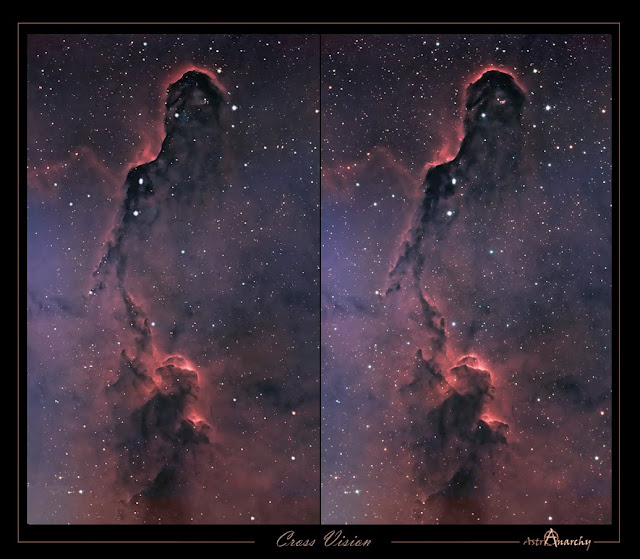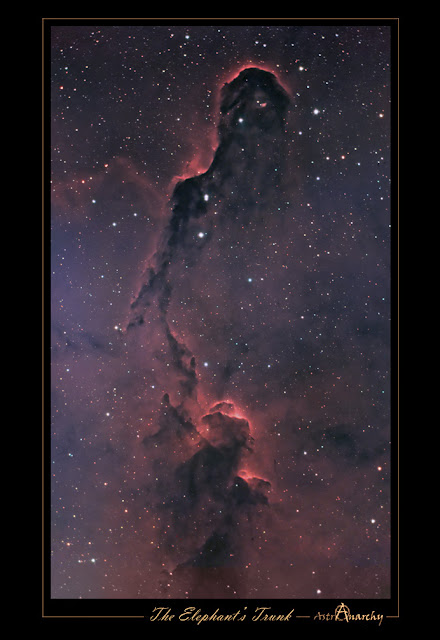COPYRIGHT, PLEASE NOTE
All the material on this website is copyrighted to J-P Metsavainio, if not otherwise stated. Any content on this website may not be reproduced without the author’s permission.
Have a visit in my portfolio
PORTFOLIO:https://astroanarchy.zenfolio.com/
Saturday, October 31, 2009
Elephant's Trunk as a Stereogram
 For Parallel Vision
For Parallel Vision  For Cross Vision -
For Cross Vision -
NOTE! This is a personal vision about forms and shapes, based on some known facts and artistic impression. Wieving instructions can be found from a Right hand side menu. - Original Image with details can be found HERE.
Labels:
stereo images
LRGB Elephant's Trunk

I had an older version of the Elephant's Trunk from the year 2007.
It was a H-aRGB image.
This is a combination of the olde and the new images.
It can be called to a H-a, O-III and S-II boosted RGB image.
Friday, October 30, 2009
The Elephant's Trunk Nebula


In Natural colors In HST-palette - This is a detail from the Nebula IC 1396, a beautiful, sculpture like, gas formation. HERE is a wider field of view to same object. - Technical details: Two color chemes, HST Palette as S-II=Red, H-a=Green and O-III=Blue. Second image is in natural colors composed from narrowband data. Channels are balanced so, that image match to visible spectrum, H-a + 24%S-II=Red, O-III=Green and O-III + 15%H-alpha=Blue. Processing work flow: Image acquisition, MaxiDL v5.07. Stacked and calibrated in CCDStack. Deconvolution with a CCDSharp, 30 iterations. Levels, curves and color combine in PS CS3. Telescope, Meade LX200 GPS 12" @ f4.65 Camera, QHY9 Guiding, SXV-AO @ 11Hz Image Scale, 0,8 arcseconds/pixel Exposures: H-alpha 17x1200s Binned 1x1 O-III 4x600s, binned 3x3 S-II 6x600s, binned 3x3
Monday, October 19, 2009
Cat's Eye Nebula, Stereogram

Parallel Vision
 Cross Vision - -
Cross Vision - -
 Cross Vision - -
Cross Vision - -
NOTE! This is a personal vision about forms and shapes, based on some known facts and artistic impression. Wieving instructions can be found from a Right hand side menu. - Original Image with details can be found HERE.
-
Cat's Eye Stereogram in a HST-palette
Labels:
stereo images
Cat's Eye Nebula


Outer shell is very dim and the core of the Nebula is so bright, balancing that is not an easy task.
I'm happy with this result!
The core of the Cat's Eye Nebula has a small angular diameter, so good seeing is needed to reveal any internal details. I managesd to get some visible by using seceral relatively short exposures, 150s. each, for the core. Seeing varys between 3-2,2 FWHM.
There is a hint of cocentric circles visible around the core, ,they are real phenomen coused by polarized light from the nebula.
 Gropped center from the image above.
Gropped center from the image above.
They are very well seen in Hubble's image of the Cat's Eye Nebula HERE:
-
Two color chemes, HST Palette as S-II=Red, H-a=Green and O-III=Blue. Second image is in natural colors composed from narrowband data. Channels are balanced so, that image match to visible spectrum, H-a + 24%S-II=Red, O-III=Green and O-III + 15%H-alpha=Blue. - Processing work flow: Image acquisition, MaxiDL v5.07. Stacked and calibrated in CCDStack. Deconvolution with a CCDSharp, 30 iterations. Levels, curves and color combine in PS CS3. Mild wavelets to the core with RegiStax5 - -Telescope, Meade LX200 GPS 12" @ f4.65 Camera, QHY9 Guiding, SXV-AO @ 11Hz Image Scale, 0,8 arcseconds/pixel Exposures: H-alpha 9x1200s Binned 1x1 + 22x300s Binned 1x1 for the Core O-III 12x1200s, binned 1x1 + 15x150s Binned 1x1 for the Core S-II 4x600s, binned 1x1 Thursday, October 15, 2009
The Tulip Nebula as a Stereogram
 Parallel, Natural Colors
Parallel, Natural Colors  Cross, Natural Colors
Cross, Natural Colors  Parallel Vision, HST-palette
Parallel Vision, HST-palette  Cross Vision , HST-palette
Cross Vision , HST-paletteNOTE! This is a personal vision about forms and shapes, based on some known facts and artistic impression. Wieving instructions can be found from a Right hand side menu. - Original Image with details can be found HERE.
Labels:
stereo images
A new project, The Cat's Eye Nebula

Cat's Eye nebula is a small, complex structured, Planetary nebula in constellation Drago.
In this first version, only H-alpha light is exposed. There is strong O-III component in its halo.
Doe its small angular size, good seeing is needed to show any internal details in nebula's core.
Seeing was really bad and I just tryed to capture H-a for outer halo.
However, there was some details in bright core as well.
-
Details;
-Camera, QHY9
- Optics, Meade LX200 GPS 12" @ f4.65
- Guiding, Lodestar and SXV-AO @ 8Hz
- Exposures, 10x600s and 4x1200s with 7nm H-alpha filter.
- image scale is 0.8 arcsecond/pixel
-
-
A "pre Stereogram"
 Parallel
Parallel
Cross
Wednesday, October 14, 2009
Tulip Nebula Finalized


Last night I got more H-alpha light and O-III and S-II channels.
-
Two color chemes, HST Palette as S-II=Red, H-a=Green and O-III=Blue. Second image is in natural colors composed from narrowband data. Channels are balanced so, that image match to visible spectrum, H-a + 24%S-II=Red, O-III=Green and O-III + 15%H-alpha=Blue.
-
Processing work flow: Image acquisition, MaxiDL v5.07. Stacked and calibrated in CCDStack. Deconvolution with a CCDSharp, 30 iterations. Levels, curves and color combine in PS CS3.
- Telescope, Meade LX200 GPS 12" @ f4.65 Camera, QHY9
Guiding, SXV-AO @ 11Hz
Exposures: H-alpha 10x1200s Binned 1x1
O-III 6x600s, binned 3x3
S-II 4x600s, binned 3x3
-

The name "Tulip" is well deserved.
Monday, October 12, 2009
NGC 6888, Reprocessed

Colors are now more vivid and details are even more visible.
Original images and imaging details can be found here:
-
Sunday, October 11, 2009
New project, The Tulip Nebula


I have started a new project with a Sh2-101, the Tulip Nebula.
So far, from three nights, I have only four twenty minutes exposures. Weather has been very volatile up here.
I will shoot more H-alpha and other channels for this object later.
-
Two color chemes, HST Palette as S-II=Red, H-a=Green and O-III=Blue.
Second image is in natural colors composed from narrowband data.
Channels are balanced so, that image match to visible spectrum,
H-a + 24%S-II=Red, O-III=Green and O-III + 15%H-alpha=Blue.
-
Processing work flow:
Image acquisition, MaxiDL v5.07.
Stacked and calibrated in CCDStack.
Deconvolution with a CCDSharp, 30 iterations.
Levels, curves and color combine in PS CS3.
Telescope, Meade LX200 GPS 12" @ f4.65
Camera, QHY9 Guiding, SXV-AO @ 11Hz
Exposures:
H-alpha 4x1200s Binned 1x1
Color information is taken from much wider fiels image of Tulip Nebula.
Wednesday, October 7, 2009
The Bubble Nbula as a Stereogram
 Parallel Vision, HST-palette
Parallel Vision, HST-palette  Cross Vision, HST-palette
Cross Vision, HST-palette  Parallel Vision, Natural-palette
Parallel Vision, Natural-palette
- NOTE!
This is a personal vision about forms and shapes, based on some known facts and artistic impression.
Wieving instructions can be found from a Right hand side menu.
-
Original Image with details can be found HERE.
Labels:
stereo images
Sunday, October 4, 2009
Bubble Nebula finalized


Now I have data for all the channels, H-alpha, S-II and O-III.Even though signal from S-II was very weak it was clearly there, I managed to balance it with stronge channels.
-
Two color chemes, HST Palette as S-II=Red, H-a=Green and O-III=Blue.
Second image is in natural colors composed from narrowband data.
Channels are balanced so, that image match to visible spectrum,
H-a + 24%S-II=Red, O-III=Green and O-III + 15%H-alpha=Blue.
-
Processing work flow: Image acquisition, MaxiDL v5.07. Stacked and calibrated in CCDStack. Deconvolution with a CCDSharp, 30 iterations. Levels, curves and color combine in PS CS3. - Imaeged in three nights between 27.09 - 04-09 2009, seeing varys between 4-2,5 FWHM - Telescope, Meade LX200 GPS 12" @ f4.65 Camera, QHY9 Guiding, SXV-AO @ 11Hz
Exposures:
H-alpha 21x1200s Binned 1x1 = 7h
S-II 10x600s Binned 3x3
O-III 5x600s Binned 3x3
-

Here is a total captured Field of View, image size is about 3500 x2300 pixels.
Image turned to be a very high resolution one. Image scale is 0.8 arc seconds/pixel.
Seeing wasn't that good (2,5 FWHM at best) but slightly oversampled image is very good for Deconvolution algorithms. After deconvolution the FWHM was 1.9.
Saturday, October 3, 2009
Bubble Nebula in a H-alpha light


I have started again a new imaging project.
Image is exposed 7 hours so far, 21 x 1200s.
The RGB data in color image was imaged in 2007 with a QHY8 camera.
Image is gropped from large image and scaled down about 50%.
-
Processing work flow:
Image acquisition, MaxiDL v5.07.
Stacked and calibrated in CCDStack.
Deconvolution with a CCDSharp, 30 iterations.
Levels, curves and color combine in PS CS3.
-
Imeged in two nights, seeing varys between 4-2,5 FWHM
-
Telescope, Meade LX200 GPS 12" @ f4.65
Camera, QHY9
Guiding, SXV-AO @ 11Hz
Subscribe to:
Posts (Atom)















